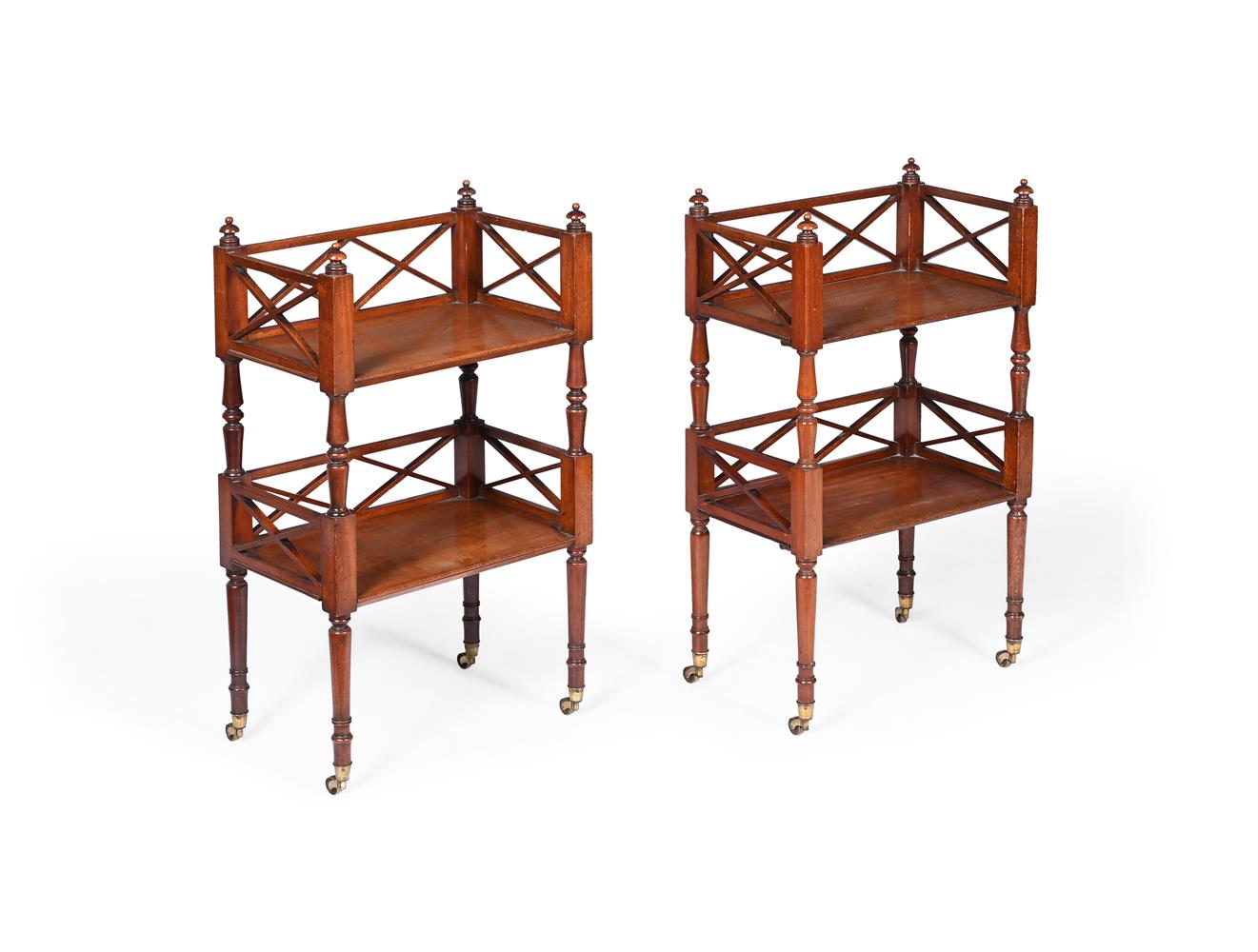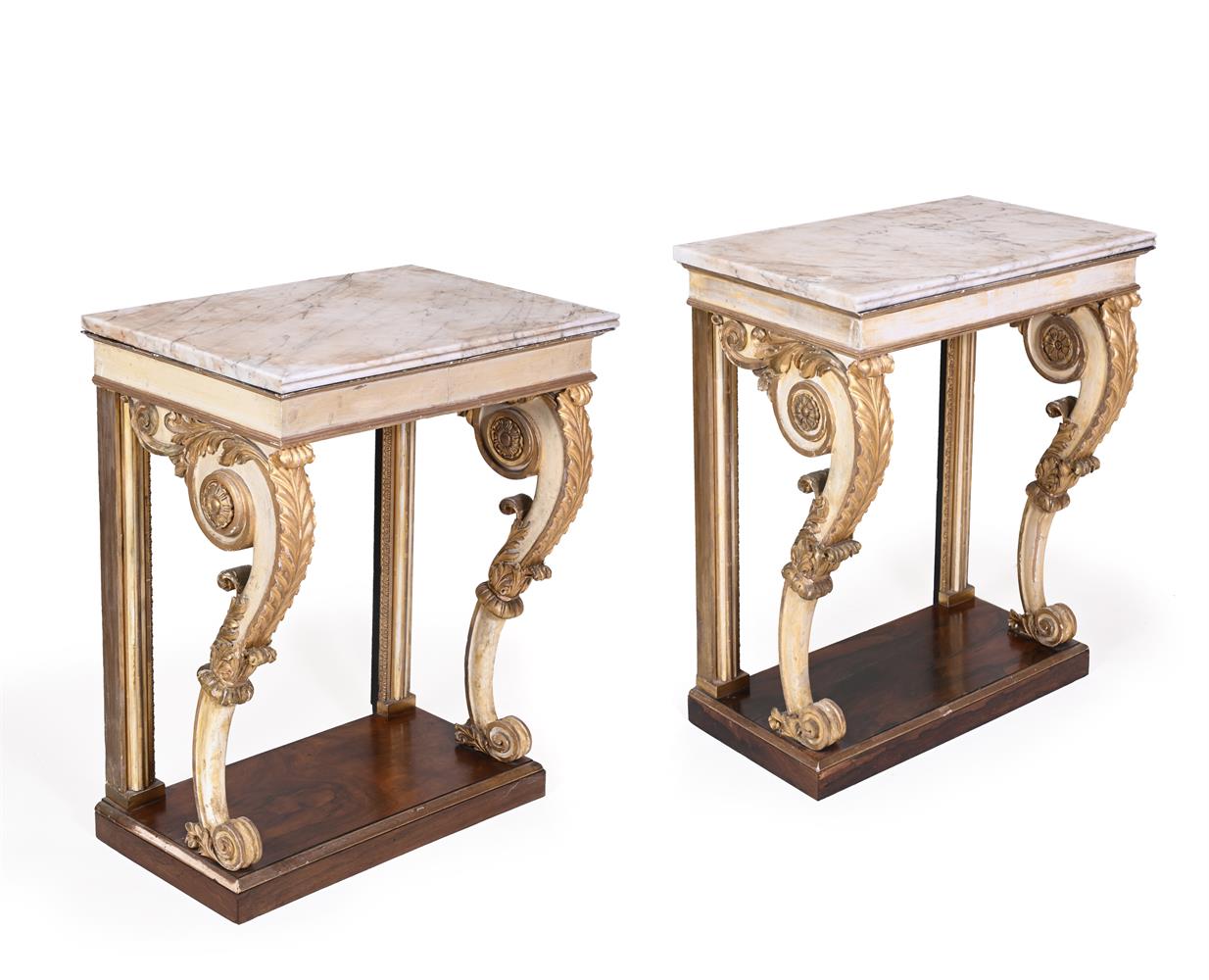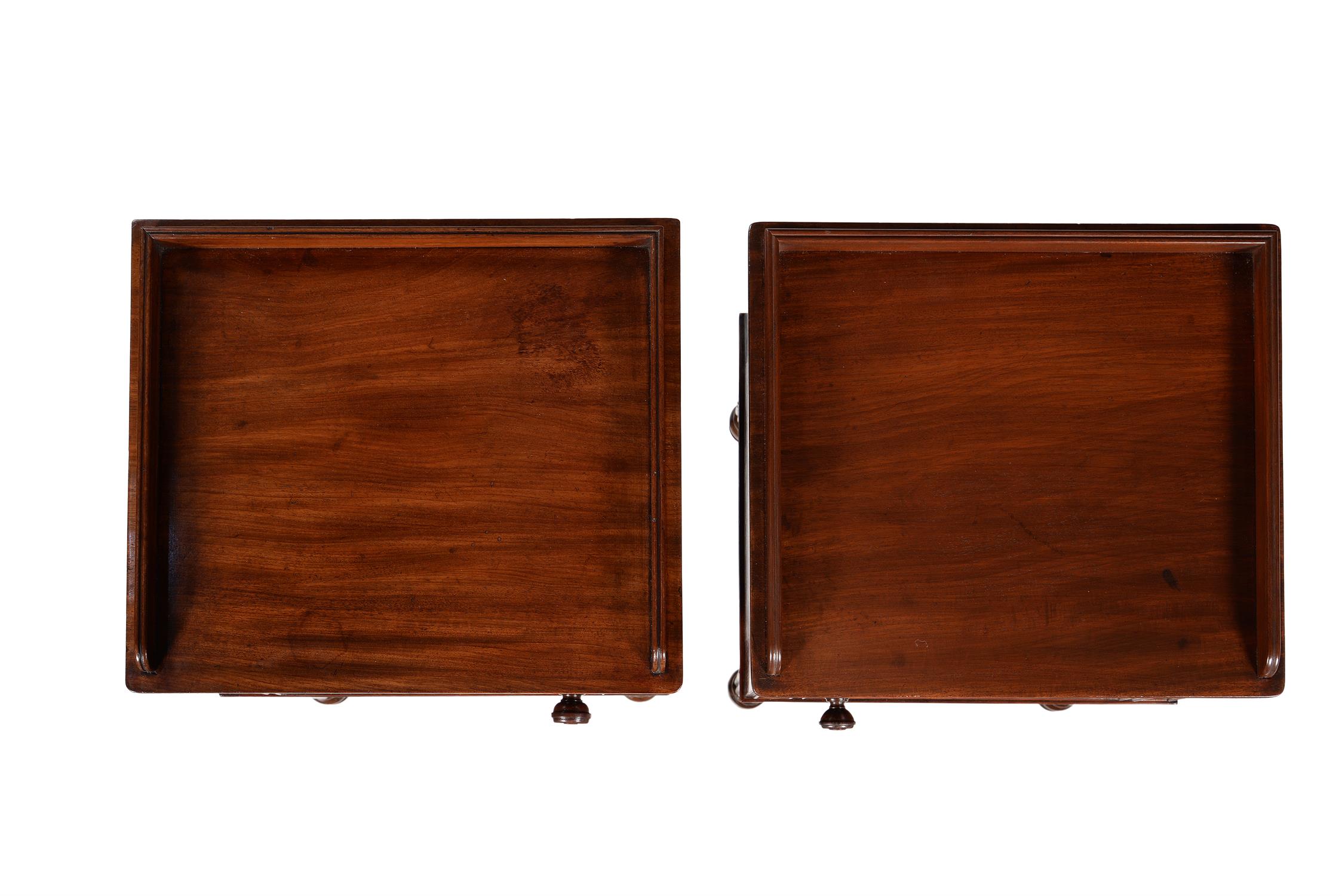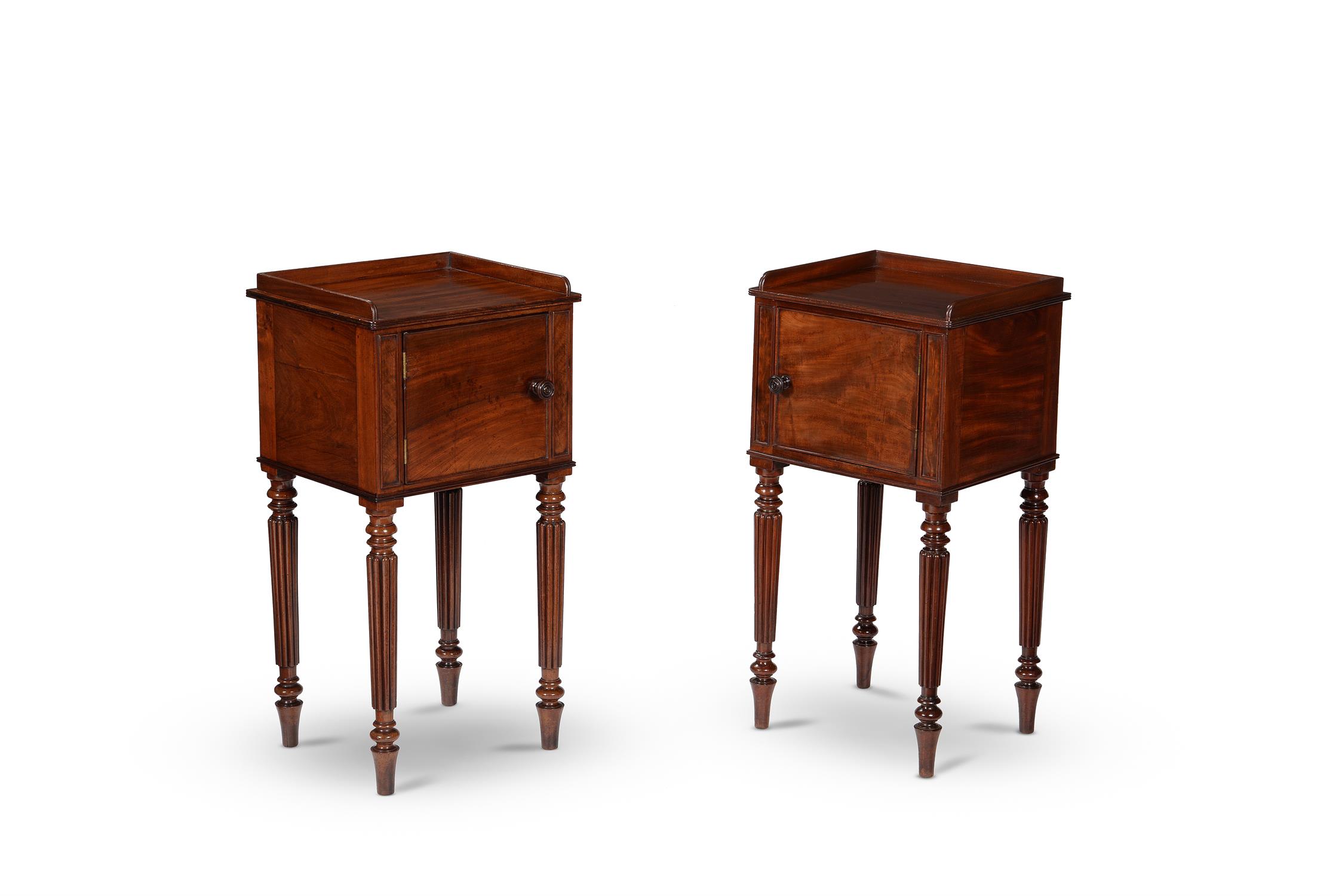A MATCHED PAIR OF CHARLES II KINGWOOD OYSTER VENEERED WALL MIRRORS IN THE MANNER OF THOMAS PISTOR, CIRCA 1685 Of slightly varying proportions, one 130cm high, 100cm wide, the other 127.5cm high, 98cm wide Provenance: Formerly at Chirk Castle Christie's, Chirk Castle, 21st June 2004, Lot 130 Literature: Illustrated in situ in the Long Gallery in The Hon. Mrs Mary Wombwell's watercolour of 1861 and in a late 19th Century photograph published in the National Trust Guide Book, 1983, p.25. C. Hussey 'Chirk Castle', Country Life, 5 October 1951, fig.8. (illustrated in situ in the Corridor). Catalogue note: These Charles II pier-glasses, with bevelled Vauxhall plate, have bolection- moulded Kingwood frames superbly parquetried in a wave scrolled figuring and central mosaic- parquertried medallion of shell scalloped 'oyster' veneer. These mirrors, of exceptional scale for their date, were almost certainly commissioned for the Long Gallery at Chirk. Built by Sir Thomas Myddleton ( d.1684), 2nd Brat, the Long Gallery was begun in 1670 and was substantially complete in 1678, when the sum of £100 15s 0d was paid to ' Jonathon Hooke, the Joyner, in full for all the ards at Vs per Yard'. On the same day, Thomas Dugdale was £30 'for carveing all the Carved worke at the Longe Gallery'. Both of the latter had worked at Weston Park, the ancestral home Charlotte Bridgeman, whom he married in 1677, possibly to designs by Captain William Winde Conceived as the great room of entertainment and exercise, the Long Gallery to a large extent retained its sumptuous Baroque appearance and furnishings in 1795- although when Lady Sykes visited in 1796 she found furnishings ' so crowded together they are seen to great disadvantage'. Thus the great series of portraits in their original Sunderland frames hung above a parade of lavish cabinets,including the pietra Dura cabinets on George I gilt-gesso stands acquired on the Grand Tour by Roberth Myddleton (d.1733), as well as the Charles II silver-mounted Royal Presentation cabinet described as having 'Silver 'd Ornaments' (both of which remain at Chirk). Taking centre stage was the harpsicord by Burkhat Sindi, like that acquired by George III, dated 1742 but actually moved to Chirk in 1766 (still at Chirk), and 'Billyard Table', the first of which was installed in 1686. This rare pair of mirrors are almost certainly the '2 Pier Glasses 10.0.0' recorded in the 1795 Inventory. Although the description is all but brief, a watercolour by the Hon. Mrs Mary Wombwell of the Long Gallery, dated Sept. 20th 1861 (from an album still owned by the Myddleton family), as well as the undated later 19th century photograph of the Gallery- both show one of these mirrors above the fireplace at the South end. Both also clearly reveal how much of the furnishings from the 1795 arrangement survive , in spite of alterations apparently carried out in the 1840s and illustrated in Lady Hester Leeke's watercolour of 1840-7-although the panelling has returned by 1861. A smaller mirror of directly comparable design- still owned by the family - is possibly the 'Chimney Glass 0.18.0' listed in 1795 in that same room- although this much larger pair of mirrors was certainly placed above the fireplaces at each end by both the undated photograph and an Inventory carried out circa 1910 ('pier glass over fire place Rose wood frame North End' and '1 pier glass over fire place rosewood frame South End'). Undoubtedly originally supplied with matching pair of 'pier' or dressing tables, related 'cushion frame' mirrors are discussed by A. Bowett in English Furniture 1660-1714, Woodbridge, 2002, pp. 136-9, including a smaller example at Nunnington Hall. Like the Chirk mirrors, this also has slots cut into the back to house the cresting- although there is no evidence that any cresting was ever fitted. This is possibly the case with the Chirk Mirrors.
A MATCHED PAIR OF CHARLES II KINGWOOD OYSTER VENEERED WALL MIRRORS IN THE MANNER OF THOMAS PISTOR, CIRCA 1685 Of slightly varying proportions, one 130cm high, 100cm wide, the other 127.5cm high, 98cm wide Provenance: Formerly at Chirk Castle Christie's, Chirk Castle, 21st June 2004, Lot 130 Literature: Illustrated in situ in the Long Gallery in The Hon. Mrs Mary Wombwell's watercolour of 1861 and in a late 19th Century photograph published in the National Trust Guide Book, 1983, p.25. C. Hussey 'Chirk Castle', Country Life, 5 October 1951, fig.8. (illustrated in situ in the Corridor). Catalogue note: These Charles II pier-glasses, with bevelled Vauxhall plate, have bolection- moulded Kingwood frames superbly parquetried in a wave scrolled figuring and central mosaic- parquertried medallion of shell scalloped 'oyster' veneer. These mirrors, of exceptional scale for their date, were almost certainly commissioned for the Long Gallery at Chirk. Built by Sir Thomas Myddleton ( d.1684), 2nd Brat, the Long Gallery was begun in 1670 and was substantially complete in 1678, when the sum of £100 15s 0d was paid to ' Jonathon Hooke, the Joyner, in full for all the ards at Vs per Yard'. On the same day, Thomas Dugdale was £30 'for carveing all the Carved worke at the Longe Gallery'. Both of the latter had worked at Weston Park, the ancestral home Charlotte Bridgeman, whom he married in 1677, possibly to designs by Captain William Winde Conceived as the great room of entertainment and exercise, the Long Gallery to a large extent retained its sumptuous Baroque appearance and furnishings in 1795- although when Lady Sykes visited in 1796 she found furnishings ' so crowded together they are seen to great disadvantage'. Thus the great series of portraits in their original Sunderland frames hung above a parade of lavish cabinets,including the pietra Dura cabinets on George I gilt-gesso stands acquired on the Grand Tour by Roberth Myddleton (d.1733), as well as the Charles II silver-mounted Royal Presentation cabinet described as having 'Silver 'd Ornaments' (both of which remain at Chirk). Taking centre stage was the harpsicord by Burkhat Sindi, like that acquired by George III, dated 1742 but actually moved to Chirk in 1766 (still at Chirk), and 'Billyard Table', the first of which was installed in 1686. This rare pair of mirrors are almost certainly the '2 Pier Glasses 10.0.0' recorded in the 1795 Inventory. Although the description is all but brief, a watercolour by the Hon. Mrs Mary Wombwell of the Long Gallery, dated Sept. 20th 1861 (from an album still owned by the Myddleton family), as well as the undated later 19th century photograph of the Gallery- both show one of these mirrors above the fireplace at the South end. Both also clearly reveal how much of the furnishings from the 1795 arrangement survive , in spite of alterations apparently carried out in the 1840s and illustrated in Lady Hester Leeke's watercolour of 1840-7-although the panelling has returned by 1861. A smaller mirror of directly comparable design- still owned by the family - is possibly the 'Chimney Glass 0.18.0' listed in 1795 in that same room- although this much larger pair of mirrors was certainly placed above the fireplaces at each end by both the undated photograph and an Inventory carried out circa 1910 ('pier glass over fire place Rose wood frame North End' and '1 pier glass over fire place rosewood frame South End'). Undoubtedly originally supplied with matching pair of 'pier' or dressing tables, related 'cushion frame' mirrors are discussed by A. Bowett in English Furniture 1660-1714, Woodbridge, 2002, pp. 136-9, including a smaller example at Nunnington Hall. Like the Chirk mirrors, this also has slots cut into the back to house the cresting- although there is no evidence that any cresting was ever fitted. This is possibly the case with the Chirk Mirrors.











.jpg)



Try LotSearch and its premium features for 7 days - without any costs!
Be notified automatically about new items in upcoming auctions.
Create an alert